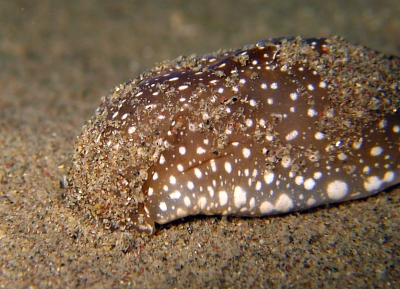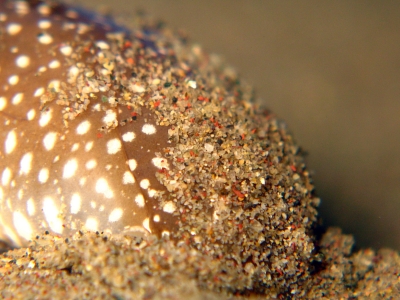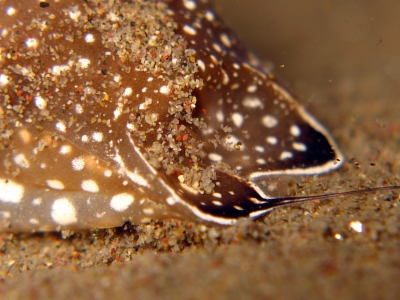Re: Aglaja tricolorata 'feeding'
September 5, 2008
From: Dominique Horst


Concerning message #21709:
Hi Bill,
We had the chance to observe an Aglaja tricolorata feeding last night.
It push the sand as a snow-plow do with the snow, the sand over it's mantle and then fall on the border or even on the trail. The one we saw was very active in making a long convoluted trail.
Locality: Cagnes, 8m, France, Mediterranean sea, 29 August 2008, muddy. Length: 40 mm. Photographer: Dominique Horst.
Kind regards,
Dominique
dominique.horst@wanadoo.fr
Horst, D., 2008 (Sep 5) Re: Aglaja tricolorata 'feeding'. [Message in] Sea Slug Forum. Australian Museum, Sydney. Available from http://www.seaslugforum.net/find/21856
Dear Dom,
When I saw your message about seeing Aglaja feeding, my heart jumped, because I am pretty sure we still don't know what species of Aglaja actually eat. As a postgraduate student, many years ago, I studied feeding in this family and found species of Melanochlamys feeding on polychaete worms and some species of Philinopsis feeding on cephalaspidean bubble shells. We now have information [see messages on Chelidonura varians] suggesting that species of that genus feed on flatworms, and there is quite a bit of research showing Navanax inermis feeds on a wide variety of opisthobranchs, including bubble-shells, sea hares and nudibranchs. But I still thinking we are waiting for information on the food of species of Aglaja.
What your animals are doing is 'ploughing' through the upper layers of the sand, perhaps trying to find food by using the sensory bristles aglajids have on each side of the mouth. Aglajids have large mucus glands along the front of the foot which produce a continuous tube of mucus through which the animal crawls. Their whole body is covered with microscopic hairs or cilia which propel them through the mucus tube. This means that as they crawl along their organs don't get clogged up with the sand or mud through which they are crawling. The sandgrains you can see travelling up over the head and down off the 'tail' are attached to a thing mucus layer.
To return to what they eat. Perhaps you could try a little experiment and try putting possible food items in their path and see if they respond. The most likely would be a bubble-shell [Haminoea perhaps?], a nudibranch, a small flatworm and a polychaete worm.
Best wishes,
Bill Rudman
Related messages
-
Re: Aglaja tricolorata 'colour variation'
From: Dominique Horst, August 17, 2009 -
A damaged Aglaja tricolorata
From: Dominique Horst, September 4, 2008 -
Aglaja tricolorata 'trailing'
From: Dominique Horst, July 17, 2008 -
Re: Aglaja tricolorata from the French mediterranean
From: Dominique Horst, July 7, 2008 -
Aglaja tricolorata from the French mediterranean
From: Dominique Horst, July 4, 2008 -
Aglaja tricolorata from Malta
From: Patricia Peels, February 1, 2007
